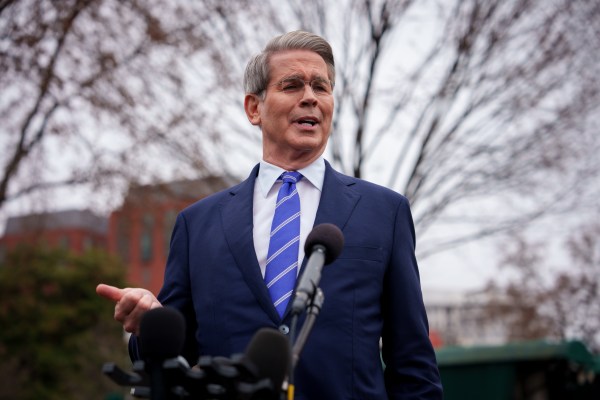Gift this article

Use the options below to copy or email a special link so that friends or family can access this article without a subscription.
Happy Tuesday! During a family vacation to Texas, former British Prime Minister Boris Johnson had a run-in with an ostrich, who pecked at the former Conservative leader through his open car window. We believe that’s what they call a “Dallas hello.”

In recent months, federal agencies have been subject to a form of the poet John Donne’s famous maxim: Ask not for whom the Department of Government Efficiency comes, it comes for thee.
This saying applies even—or perhaps especially—to the Department of Health and Human Services (HHS), an executive branch department responsible for managing some $1.7 trillion in spending, roughly a quarter of the federal budget. Mass firings have swept HHS since early last week, as many employees arrived to work to discover that their key cards no longer granted them access to office buildings.
By the end of the week, some 10,000 employees—out of around 80,000 employed by HHS—had received termination notices. The dismissals came on top of the 10,000 HHS employees who had already taken the early retirement and voluntary separation offers pushed by the administration in recent months. Meanwhile, HHS Secretary Robert F. Kennedy Jr. ordered that contracts, including for services like IT support or specialized equipment like outside lab testing, be slashed by 35 percent. Scientists and other support staff from the National Institutes of Health (NIH), which has already faced extensive cuts, are also expected to be imminently laid off.
Much of the aggressive downsizing will face legal challenges. But if the cuts go through, they would constitute a major reorganization of one of America’s largest federal departments—and could undermine the health secretary’s stated goal to “Make America Healthy Again.”
When Kennedy assumed leadership of the department, he promised to make sweeping changes to how the government approaches American health care, focusing not only on the much-discussed area of vaccines but on broader policies related to nutrition, pollution, and food safety. Kennedy has described chronic diseases as an “existential” threat to the U.S., attributing their proliferation among Americans to chemicals and toxins in the food system, poor lifestyle choices, and an overreliance on medication.
“The first thing I’ve done every morning for the past 20 years is to get on my knees and pray to God that he would put me in a position to end the chronic disease epidemic and to help America’s children,” Kennedy said in the opening statement of his Senate confirmation hearing in January. In his first speech to HHS employees after being confirmed in February, he also highlighted fighting chronic disease as his main focus.
But some public health professionals view Kennedy’s definition of chronic illness as somewhat idiosyncratic. “I think the fundamental disconnect is how the secretary is defining chronic diseases, which is not necessarily the same as how experts in the field would,” Dr. Anand Parekh, the chief medical adviser at the Bipartisan Policy Center and a former deputy assistant secretary at HHS, told TMD. Parekh pointed out that while much of Kennedy’s rhetoric on the causes of chronic illness focuses on toxins in food and the environment, the traditional definition used by medical professionals includes factors like obesity, mental health issues, substance abuse—as well as what are called “social determinants of health,” like access to housing.
Take tobacco use, the leading cause of preventable death in the United States, for example. Last week, much of the staff of the Centers for Disease Control and Prevention (CDC) Office on Smoking and Health was placed on leave, along with employees of the Food and Drug Administration’s (FDA) Center for Tobacco Products. The former group investigated national changes in tobacco use, like the rise of vaping in the late 2010s, while the latter was charged with enforcing rules on the labeling and marketing of tobacco products. “How is that going to help you reverse the chronic disease epidemic?” Parekh asked.
But other cuts were more in line with Kennedy’s public agenda. A CDC team that worked on expanding access to vaccines was scrapped, while Dr. Peter Marks—the FDA’s top vaccine regulator—resigned under apparent pressure from the administration. The press release announcing the HHS reorganization noted that the agency’s new priority for preventing chronic disease would be “safe, wholesome food, clean water, and the elimination of environmental toxins,” overseen in large part by a new division called the Administration for a Healthy America.
Many programs aimed at preventing the transmission of HIV have also faced cuts, with home testing kits and national surveys of individuals living with and at risk of HIV on the chopping block. The department also suspended funds to initiatives like the AIDS Clinical Trial Group, which conducts research on experimental treatments for the disease.
Meanwhile, some 170 employees of the FDA’s Office of Inspections and Investigations were dismissed last week, cuts that will likely mean fewer food inspections. The move appears to clash with Kennedy’s “Make America Healthy Again” initiative, which specifically states that workforce reductions won’t affect food reviewers.
On Thursday, Kennedy indicated plans to walk back some of the sweeping layoffs. “Personnel that should not have been cut were cut—we’re reinstating them, and that was always the plan,” he said. “The part of that, DOGE—we talked about this from the beginning—is we’re going to do 80 percent cuts but 20 percent of those are going to have to be reinstalled because we’ll make mistakes.” Kennedy’s statement drew on Elon Musk’s longstanding corporate strategy of cutting “too much” and fixing problems after the fact, a blueprint he has since sought to bring to the federal government.
But Kennedy’s cuts might run into another problem: federal judges. Zachary Price, a professor at the University of California College of the Law, San Francisco, told TMD that the vast array of cuts faced three potential legal challenges: Entities created by law cannot be eliminated by the executive branch at will; congressionally appropriated money must be spent, according to longstanding U.S. legal practice; and federal employees must generally be terminated by following specific procedures.
On Friday, for example, 16 states sued the Trump administration over its efforts to withhold NIH grants from public health and medical research institutions. In an unrelated case on Friday, a federal judge banned the Trump administration from drastically lowering a cap on funding to “indirect costs” for research, which include expenses like facilities and support staff.
But there may be limits to the judicial branch’s ability to rein in the sweeping cuts. “I’m not sure that courts will just undo everything,” Price noted. “It’s not the type of thing that courts normally do: to say that whole programs have to keep running and order people to do that.” There is simply not much precedent for the type of judicial oversight needed to keep specific public health programs running, he argued.
Congress, on the other hand, may be better equipped to check the executive branch’s efforts to target the department’s programs and personnel. Lawmakers could threaten to withhold funds for Trump-backed initiatives, strip certain presidential powers, or refuse to pass the president’s preferred legislation in protest of the HHS cuts.
But so far, there seems to be little appetite for that sort of confrontation. As the layoffs began to take effect, Republican Sen. Bill Cassidy and independent Sen. Bernie Sanders—the chairman and ranking member of the Senate health committee—requested that Kennedy appear before lawmakers for a hearing on his department’s reorganization. But Kennedy’s team has yet to confirm his attendance, and Republican pushback to his cuts remains minimal.
For now, the elimination and reorganization of large portions of the HHS appears poised to continue. When can Americans expect to feel the cuts? “There’s going to be a little bit of a lag,” Parekh told TMD, pointing to the potential of slower responses to the outbreak of infectious diseases and difficulties in accessing services like substance abuse treatment and support for the disabled.
“Three months out, six months out, unless this is done in a thoughtful, transparent way, there are going to be things that fall through the cracks,” he added. “If they fall through the cracks, they will affect real people, in real ways.”







Axios: Trump Tells Bibi To Be ‘Reasonable’ With Turkey, Praises ‘Very Smart’ Turkish Leader Erdoğan
Politico: Stocks Swing After Unverified X Post Said Trump Was Considering a Tariff Pause
Markets took a stunning swing Monday morning after an account on the social platform X erroneously claimed that President Donald Trump was weighing a 90-day pause on his sweeping tariffs.
The unsubstantiated report added trillions of dollars to the S&P 500 within minutes of the headline. Those gains quickly wiped out after the White House denied the substance of the post.
Nearly two years after Wes Anderson first teased his newest project, the iconic director finally released the first trailer for The Phoenician Scheme on Monday. The film starring Benicio del Toro, Mia Threapleton, and Michael Cera is set to hit theaters on May 30.
Do you share Kennedy’s concerns about America’s chronic disease epidemic? Do you agree with his proposed solutions?